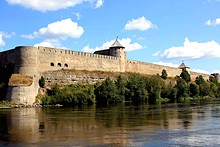Museums of History and Politics
Since its founding in 1703, St. Petersburg has been at the center of an endless series of major historical events, first as the capital of the vast Russian Empire, then as the cradle of the Bolshevik Revolution, and since then as the second city of the Soviet Union and modern Russia. To better help you understand the vital role the city has played, there are a number of museums on offer which chart different aspects of the story of the city that has been known as Petersburg, Petrograd, Leningrad, and St. Petersburg.
One of the city's most famous landmarks, the Peter and Paul Fortress is a must-see destination for all visitors to St. Petersburg, and also contains a number of museums, including the headquarters of the St. Petersburg City History Museum.
Infamous as the ship which started the October Revolution by firing blank shells towards the Winter Palace, the Cruiser Aurora is still moored in the Neva River, and is ever-popular with visitors who want to get a fell for where history was made.
Founded on Peter the Great's decree in 1709, the museum is one of the oldest in the city. Now housed in the former building of the Royal Naval Guards Crew, it has more than 1500 exhibits including various flags, historical documents, weapons and more.
Housed in a beautiful art nouveau mansion that played a vital role in the October Revolution, the collection of this fascinating museum is constantly updated to keep pace with current affairs, and has a particularly fine collection of Soviet propaganda material.
The most extensive display to chart the history of St. Petersburg, this museum is located in a beautiful neoclassical mansion down the river from the Winter Palace. Renovations for the city's 300th anniversary have restored much of the house to its historic glories.
The wooden cabin where Peter I lived while supervising the building of St. Petersburg has been preserved in a museum on the banks of the Neva River, making it the oldest residential building in the city.
Once occupying Kazan Cathedral, this anthropological museum describes the history of religious belief from paganism to the present, with extensive collections of religious art and artifacts, including separate displays for each of the major religions and main confessions of Christianity.
Probably the best of St. Petersburg's several museums chronicling the harrowing events of the 900-day Siege of Leningrad, this excellent museum contains a mixture of military memorabilia and personal civilian artifacts.
Underneath the spectacular panoramic monument that greats visitors to St. Petersburg arriving from Pulkovo Airport, this small but impressive museum is an official celebration of the heroism and endurance of the Soviet Armed Forces in their defense of Leningrad.
Part of St. Petersburg's notorious Kresty Holding Prison, which was once a model of progress, but has long been overcrowded and disease-ridden, this small museum offers an insight into the miserable lives of Russia's prison population, and is not for the faint-hearted.
This museum was originally a Lenin Memorial Museum, housed in an apartment building where he lived in the 1890s. Now it tries to provide a picture of how ordinary Petersburgers lived in the pre-Revolutionary era.
Run by the excellent Museum of Political History, this small museum next to the Admiralty displays some fascinating archive materials, including declassified KGB documents and photographs, as well as a large number of uniforms and medals.
Part of the Baltic Fleet during the Second World War, the Narodovolets has been turned into a permanent museum under the auspices of the Central Naval Museum. On guided tours, visitors have full access to the authentic interiors of the vessel.
Covering two sites near the suburb of Sestroretsk, this museum complex charts the days in the summer of 1917 that Valdimir Lenin spent hiding from the authorities , first in a worker's shed and then in a hay shelter in a nearby field.
Among the oldest settlements in the north of Russia, Staraya Ladoga has a number of historic sights, including a 16th century fortress housing a museum, and two churches that date back to the 12th century, one of which still contains original frescoes.
The impressive 16th century Ivangorod Fortress stands on the Estonia-Russia border, across the river from the older Hermann Castle in Narva. It houses a museum containing a collection of works by local artists and displays connected to the history of the area.
A fortress outpost of the Novgorod Republic, this 13th century castle is a picturesque ruin located about 120 km west of St. Petersburg. Although it calls itself a museum, there are no exhibitions as such, just a rare example of Russian medieval architecture.
Located in the town of Priozersk, this originally Karelian fortress was part of the Novogorod Republic in the 14th century (when the current stone structures were built), and then passed through Lithuanian, Swedish and Finnish hands before returning to Russia in 1945.
This impressive medieval fortress at the head of the River Neva was for centuries used as a political prison, where members of the Decembrists and the People's Will were incarcerated. The Museum of the History of St. Petersburg runs displays charting this dark history.
This large Swedish castle at the centre of the town of Vyborg dates back to the 13th century, and houses displays charting the history of this much-fought-over region, which now lies close to the Finnish-Russian border.
This museum complex in and around the suburban town of Kirovsk celebrates the end of the most horrific event in St. Petersburg's history, with a wide range of educational displays in the exhibition centre and an impressive collection of WW2 military hardware.






















